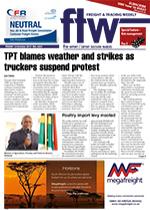Roads in the Free State are
accommodating double the
number of trucks they did
a year ago, thanks to the
resurgence in the country’s
agriculture
sector.
This
was the
heartening
news relayed
by economist
Mike
Schussler
during a
Transport
Forum
Special
Interest
Group event
held in
Johannesburg
last week.
Schussler said
roadfreight, with
around 90% of the market
share of transportable
goods in South Africa, was
up 9% versus the same
time last year, thanks to
the boom in the agriculture
sector. Rail freight volumes
are similarly up, although
its performance came
courtesy of improved bulk
commodities demand.
But while bulk
commodities like coal, iron
ore and manganese are still
in demand, the country is
becoming ever more reliant
on commodity
cycles. “Any
weakness
in that cycle
will be felt
immediately,”
he cautioned.
Schussler
said the
indicative
prices in rail
freight had
increased
tremendously,
partly due
to the surge
in iron
ore demand and partly
due to cost pressures
inherent in state-owned
enterprises (SOEs). “Our
SOEs are unable to keep
their costs down, which
presents a significant
problem.”
He said seafreight
volumes were up 4.9%
compared to last month,
with imports up 10%.
However, the country’s
export market was f lat and
breakbulk cargo was down
9.6% on a year ago.
“Container throughput
indicates there has been
growth in global container
trade and that world trade
is slowly recovering. The
throughput of containers in
85 of the world’s harbours,
including Durban, has
reached a record level. If
those container volumes
continue to grow at 7.5%,
it gives us a very good idea
of how quickly the world
has become one place – and
how important transport is
going to be in it,” he said.
Schussler explained
that all emerging
market economies,
particularly those with
commodity outlooks –
Argentina, South Africa,
Russia, Brazil, Indonesia
and Mexico – had all
experienced large declines
in their currencies. This
had helped South Africa’s
mining sector survive.
“Our commodity market
also peaked much later
than the US dollar one did,
because the rand weakened.
In addition, our fall was
‘only’ about 25%, and since
then we have recovered
ground somewhat.”
He added that
most South
African
companies
needed
to invest
outside
of South
Africa. “We
used to be
an attractor
of foreign
capital. The
direct,
fixed
investment of South Africa
at the end of the second
quarter of 2017 was over
R2.8 trillion. In other
words, 60% of our GDP’s
value is being invested in
other countries.
“We are still very
much cash f low
positive, but it is
dicey,” he concluded.
INSERT & CAPTION
Container throughput
indicates there has
been growth in global
container trade and
that world trade is
slowly recovering.
– Mike Schussler
Road freight booms on agriculture yield
13 Oct 2017 - by Tristan Wiggill
0 Comments
FTW 13 October 2017

13 Oct 2017
13 Oct 2017
13 Oct 2017
13 Oct 2017
13 Oct 2017
13 Oct 2017
Border Beat
Featured Jobs
New
